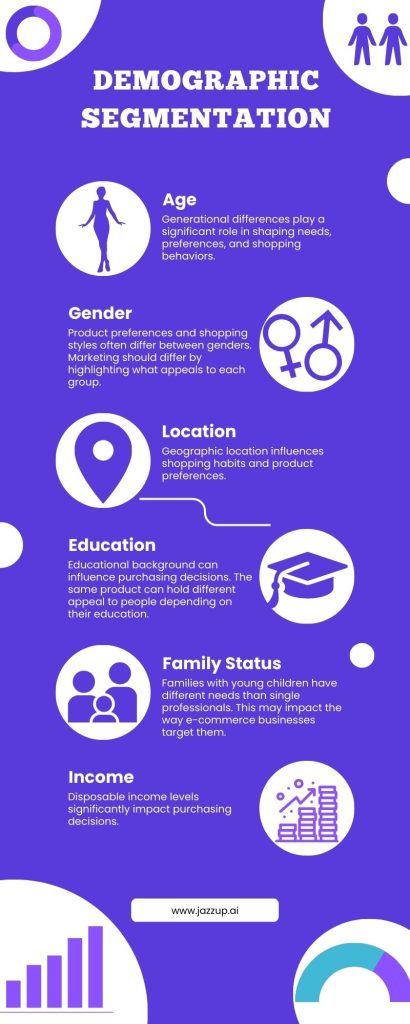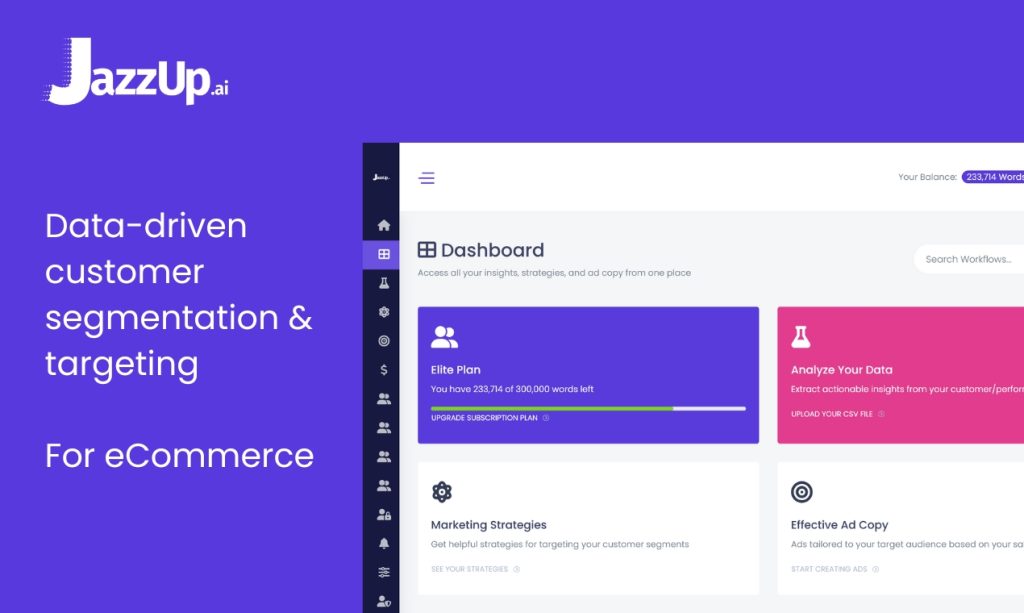
In our previous post on the basics of customer segmentation, we explored the different types of customer segmentation strategies. In this post, we will be exploring why understanding your target audience, especially through the use of demographics segmentation in e-commerce is the key to success.
By grouping customers based on shared characteristics, you can craft targeted marketing campaigns that resonate with their specific needs and preferences. Demographic segmentation, a fundamental strategy, separates your customer base using observable characteristics like age, gender, income, location, and family status.
While it might seem like a basic approach, demographics offer a powerful foundation for building a strong customer connection. Here’s why:
Targeted Marketing
Imagine showcasing high-end jewelry to teenagers or promoting budget-friendly furniture to young professionals fresh out of college. Demographic segmentation in e-commerce allows you to tailor your marketing messages, product recommendations, and website content to resonate with specific customer groups. This laser focus leads to higher engagement and conversion rates.
Improved Customer Experience
Understanding your customers’ needs and preferences through demographics can deliver a more relevant and satisfying shopping experience. This could involve offering size recommendations for different age groups or highlighting features most relevant to specific demographics (e.g., durability for families with young children).
Increased Sales and ROI
Targeted marketing campaigns are more likely to capture attention and convert into sales. Demographic segmentation allows you to focus your marketing efforts on high-potential customer groups, maximizing your return on investment (ROI).
The power of demographics in e-commerce is undeniable. Consider this: A 2023 report by eMarketer predicts Gen Z consumers (born between 1997-2012) will had a whopping $360 billion in spending power. Understanding their spending habits and preferences allows brands to tailor product offerings and marketing messages to resonate with this influential demographic.
Furthermore, Statista projects that mobile commerce (m-commerce) sales will account for 73.5% of all e-commerce sales worldwide by 2025. By segmenting by age, you can identify demographics most likely to shop on mobile devices. This allows you to optimize your website and marketing campaigns for a seamless mobile experience, catering to the ever-growing mobile shopping trend.
These are just a few examples of how demographics can empower e-commerce businesses to target the right audience, deliver exceptional customer experiences, and drive sales. But demographics are just the first step. In the coming sections, we’ll dive deeper into customer segmentation, exploring its nuances and how it integrates with other strategies to create a winning e-commerce formula.
Understanding Demographics: A Foundation for E-commerce Customer Segmentation

Demographic segmentation is a customer segmentation strategy that groups customers based on shared, observable characteristics. These characteristics typically include:
- Age: Generational differences play a significant role in shaping needs, preferences, and shopping behaviors. For instance, millennials might prioritize trendy and eco-friendly clothing, while baby boomers might focus on comfort and durability.
- Gender: Product preferences and shopping styles often differ between genders. An athletic apparel brand might create separate marketing campaigns for men and women, highlighting features most relevant to each group.
- Income: Disposable income levels significantly impact purchasing decisions. A luxury watch retailer wouldn’t target the same marketing messages as a discount clothing store.
- Location: Geographic location influences shopping habits and product preferences. An online gardening store might tailor its offerings and promotions based on regional climates and gardening trends.
- Family Status: Families with young children have different needs than single professionals. An e-commerce furniture store might segment its audience by family status, showcasing family-friendly furniture options and highlighting features like durability and easy cleaning for parents.
- Education: Educational background can influence purchasing decisions. A scientific calculator wouldn’t be marketed the same way to a high school student as it would be to an engineering professional.
Using Machine Learning for E-Commerce Customer Segmentation: JazzUp AI

Using the right techniques for data analysis and customer segmentation can improve your e-commerce targeting and conversion. However, for small e-commerce businesses who don’t have the technical know-how to analyze data, it can seem like a herculean task. JazzUp AI provides customer segmentation solutions that analyze your data for insights, segment your customers into groups, and create a marketing strategy, ad copy and even visual templates for email and social media marketing.
Think of JazzUp AI as your marketing analytics team without the huge wage bill. JazzUp requires no previous technical experience. You can connect directly to your Shopify or Wix store or upload sales data via CSV and you’ll have your insights and marketing strategy in minutes.
Ready for laser-sharp insights? Sign up to JazzUp AI today.
Beyond Demographics: Understanding Customer Needs and Behaviors
By analyzing demographic data, e-commerce businesses can gain valuable insights into their customer base:
- Needs: Understanding the age group allows you to tailor product offerings and marketing messages to address their specific needs. For example, an online mattress store might highlight the importance of back support for older demographics, while focusing on trendy designs for younger customers.
- Preferences: Demographics can provide clues about customer preferences for style, brand, and functionality. Knowing the income level of your target audience helps you determine the appropriate price range and value proposition for your products.
- Shopping Behaviors: Demographics can shed light on how customers prefer to shop online. Younger generations might be more comfortable with mobile shopping, while older demographics might prefer a traditional desktop experience. This allows you to optimize your website and marketing campaigns for the preferred channels of your target audience.
Limitations of Demographic Segmentation: A Balanced Approach
While demographic segmentation offers a strong foundation, it’s crucial to acknowledge its limitations:
- Oversimplification: Demographics paint a general picture, but they don’t tell the whole story. A 25-year-old woman with a high income might have very different shopping habits than another 25-year-old woman with a lower income. Demographic segmentation needs to be layered with other strategies for a more complete understanding.
- Evolving Demographics: Consumer preferences and behaviors are constantly changing. Demographic data needs to be regularly updated to maintain its effectiveness. For instance, the spending habits of Gen Z are constantly evolving, requiring brands to stay updated on their latest preferences.
- Neglecting Valuable Segments: Relying solely on demographics can lead you to overlook potentially valuable customer segments that don’t fit neatly into predefined categories. There might be a niche group within a broader demographic that has unique needs and deserves targeted marketing efforts.
Examples of Demographics in E-Commerce Segmentation
Here’s how e-commerce businesses can leverage demographics for effective segmentation:
Athletic Apparel Brand:
Millennials: Focus on social media marketing showcasing trendy workout clothes with features like moisture-wicking technology and bold designs.
Baby Boomers: Utilize email campaigns highlighting the comfort and durability of their activewear, emphasizing features like easy care and joint support.
Beauty Brand:
Younger Demographics: Create a product line focused on trendy makeup palettes and bold colors, and leverage influencer marketing on platforms like TikTok and Instagram.
Mature Demographics: Develop an anti-aging skincare line and target them with email campaigns featuring models in their age group and testimonials from satisfied customers.
Subscription Box Service:
Families with Young Children: Offer a curated box filled with educational toys, art supplies, and age-appropriate activities.
Young Professionals: Create a subscription box featuring healthy snacks, self-care products, and productivity tools.
These are just a few examples, but they illustrate the power of demographic segmentation in crafting targeted marketing campaigns that resonate with specific customer groups. However, it’s important to remember that demographics are just one piece of the puzzle. In the next section, we’ll explore how to combine demographic segmentation with other strategies for a more holistic view of your audience.
Beyond Demographics: Combining E-Commerce Segmentation Strategies for Better Insights
While demographic segmentation provides a valuable foundation, it’s just the first step in understanding your e-commerce audience. For a truly comprehensive view, consider layering on other segmentation strategies:
Psychographic Segmentation: Understanding Why Customers Buy

Psychographic segmentation delves deeper than demographics, focusing on a customer’s:
- Lifestyle: How do they spend their free time? Are they active and outdoorsy, or do they prefer a more relaxed pace?
- Values: What’s important to them? Do they prioritize sustainability, quality, or affordability?
- Interests: What are their hobbies and passions? Are they gamers, foodies, or DIY enthusiasts?
- Personalities: Are they outgoing and social, or more introverted and analytical?
Understanding these psychographics allows you to tailor your marketing messages to resonate with a customer’s deeper motivations and aspirations. Imagine targeting an athletic apparel brand’s marketing campaign not just at millennials but specifically at millennials who value sustainability and ethical production. This allows you to connect with them deeper and showcase how your brand aligns with their values.
Behavioral Segmentation: Understanding Customer Actions

Behavioral segmentation groups customers based on their past purchase behavior and website interactions. Consider factors like:
- Purchase History: What products have they bought in the past? This allows you to recommend similar products or accessories.
- Website Interactions: What pages do they visit? How long do they stay on product pages? This data can reveal their interests and purchase intent.
- Engagement Level: Do they open your emails? Click on your social media posts? Segmenting by engagement level allows you to tailor your communication strategy for each group.
By analyzing customer behaviour, you can predict future purchases and personalize the shopping experience. For instance, an online bookstore could segment customers who buy cookbooks and recommend recipe kits or cooking tools. This targeted approach increases the likelihood of converting website visitors into loyal customers.
Combining Demographics with Other Customer Segmentation Strategies for Greater E-Commerce Insights
The true magic happens when you combine demographic, psychographic, and behavioral segmentation. This allows you to create highly targeted customer profiles that paint a rich picture of who your ideal customer is:
A 30-year-old professional woman (demographic) who prioritizes healthy living and sustainability (psychographic) and frequently purchases organic groceries online (behavioral). This profile allows you to target her with marketing campaigns for organic meal kits and eco-friendly kitchenware.
By combining these strategies, you can craft personalized marketing messages, product recommendations, and website experiences that resonate on a deeper level. This personalized approach increases customer satisfaction, brand loyalty, and, ultimately, higher sales.
Combining Segmentation Strategies with JazzUp AI
As we shared, merging customer segmentation strategies can provide clearer insights for your data, allow you to create niche segments for your customers. While this is rewarding, it can be taxing for people without data analytics knowledge to analyze multiple data sets. This is where Machine Learning comes in.
JazzUp AI trains your data model on your own data, reviewing customer data and gaining insights in minutes. JazzUp merges behavioral data (sales) with demographic data (customer information) to create customer segments. JazzUp also creates marketing strategies for you to effectively reach your customer segments.
JazzUp is intuitive and user-friendly so anyone who can use a computer can use JazzUp. All you need to start generating insights is a CSV file. Ready to harness the power of multiple segmentation strategies? Try JazzUp AI today
Real-World Examples: Segmentation Synergy in Action
Here’s how e-commerce businesses can leverage a combination of segmentation strategies:
- Targeting Eco-Conscious Consumers: Don’t be fooled by age. While millennials might be stereotyped as environmentally conscious, there are eco-friendly consumers across all demographics. By combining demographics (age, location) with psychographics (values, interests), you can target these consumers with relevant products (sustainable clothing, organic beauty products) regardless of age group.
- Re-Engaging Past Customers: Behavioral data is gold for re-engagement campaigns. Segment customers based on their purchase history and website interactions. For instance, you could target customers who haven’t purchased in a while with special offers or personalized recommendations based on their past purchases.
- Personalizing the Website Experience: Use website behavior data to personalize product recommendations and website content. If a customer lingers on a specific product page, showcase similar items or highlight features relevant to their interests.
These are just a few examples, but they demonstrate the power of combining segmentation strategies. By taking a multi-dimensional approach to understanding your audience, you can craft targeted marketing campaigns and personalized experiences that drive sales and build lasting customer relationships.
How to Build Your Customer Database
There are various ways to collect customer data for segmentation purposes:
- Customer Accounts: Demographic information like age, location, and income can be collected during account creation.
- Website Behavior: Analytics tools track website interactions, revealing pages visited, time spent on product pages, and purchase history.
- Surveys and Feedback Forms: Directly ask customers about their preferences, interests, and shopping habits.
- Social Media Interactions: Social media platforms offer insights into customer interests and brand perception through likes, comments, and shares.
Unlocking the Power of Data Analysis
Once you’ve collected customer data, leverage analytics tools and platforms to identify patterns and trends. This analysis allows you to segment your customer base based on the criteria discussed throughout this post.
Data-Driven Decisions for Marketing Magic
By segmenting your audience based on a rich tapestry of data, you can create marketing campaigns that are laser-focused and impactful. Imagine sending targeted email campaigns with personalized product recommendations based on a customer’s past purchases and interests. This data-driven approach fosters a deeper connection with your audience, leading to higher conversion rates and increased customer satisfaction.
Data-driven segmentation empowers you to create a personalized customer experience throughout the shopping journey. This could involve displaying relevant product recommendations on the homepage, offering personalized discounts based on purchase history, or tailoring customer service interactions to address specific customer needs. Ultimately, data-driven segmentation equips you to deliver a seamless and personalized experience that keeps customers coming back for more.


